When it comes to selling a product online, every detail matters, from the design of your website to your product images, and of course, your product titles and description. Attention-grabbing and customer-centric product descriptions and titles are not only an important aspect in convincing potential customers to buy your product; they also contribute to your search engine ranking.
Done correctly, product titles and descriptions can skyrocket your conversion rates. Accurate and well-written product descriptions and eye-catching product titles indeed play an essential role in consumers’ decision-making.
We have compiled this guide to help you better understand the importance of quality product titles and descriptions, and how you can design your eCommerce product descriptions for higher conversion rates.
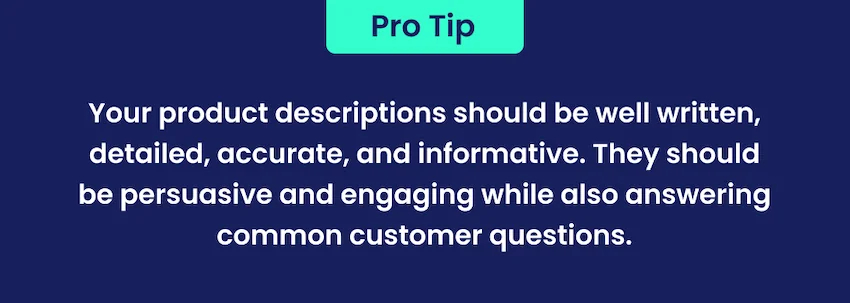
What is a Product Title and Description?
A product title is the name you choose to represent the product you are selling. The product description is the marketing copy that addresses the key features of a product, essential information about its design and usage, and why it is worth buying.
A quality product title is important because it is one of the first things potential customers see when searching for a product. The product description is essential because it is what compels the buyers to go through with their purchase. It is vital to provide your potential customers with information about the characteristics and main benefits of the products in a way that convinces consumers to purchase.
A finely crafted product description must be well written, detailed, accurate, and informative. It must also be persuasive and engaging while answering common customer queries too, including:
- What benefit are they going to get from your product?
- What problem does your product solve? What pain point does it address?
- What sets your product apart from others available on the market?
- What sizes and colors are available?
- Consider your product description as a 24/7 virtual retail associate of your eCommerce store. It explains your product to every visitor while outlining how it can improve their life. If you put effort to provide a well-crafted, audience-oriented product description, it will grab consumers’ attention and likely increase conversions.
Why are Product Descriptions and Titles Important in ECommerce?
No one wants to buy a product they are unsure about. Your product title and descriptions are one of the key identification factors and selling points for your customers.
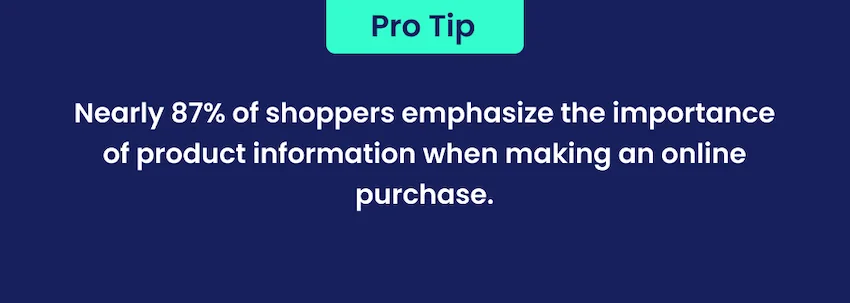
Words have a great deal of power. According to one report, nearly 87% of shoppers emphasized the importance of product information when making an online purchase. In addition, 50% of respondents stated that they had to return the item due to misleading product descriptions.
If your product titles and descriptions are unclear and confusing, your customers will likely lose interest. Nearly 20% of purchase failures occur due to vague and incomplete product descriptions.
When a consumer is deciding what to buy and can only see images of the product, they’ll have a lot of questions that go unanswered. For example, they may want to know what material the product is made from, what the product is suitable for, the size of the product, and more. Without answers to these questions, customers are not likely to go through the purchase.
In addition, product descriptions and titles also help to increase your product’s ranking on search engines. As a retailer, you would know the importance of optimizing your website with SEO for better ranking. Your product title and descriptions also play the same role.
When someone searches for the name of your product or the key features mentioned in your product description, you want your product to show up. Putting accurate information and keywords in your product title and descriptions helps you rank higher, which is a sure way of getting your product in front of potential buyers.
Another benefit about product descriptions is that they give you space to answer frequently asked questions about your product. It’s the perfect spot to provide customers with all of the information they may want to know, so they can go ahead and click that “buy” button. If they have to reach out to customer support or click around to find the information they need, they’re much less likely to actually convert.
How To Write Product Titles and Descriptions for ECommerce
Remember, product descriptions must be crafted with the buyers in mind. You want to provide them with the information they want in an easy to read, digestible way rather than just stating the product’s features. No matter what product category you sell, a well-crafted, compelling, customer-centric description is essential.
Below we have discussed some key points to keep in mind when writing product descriptions and titles, using some examples to help.
1. Determine the key format for your product
Although there are many points of consideration while crafting descriptions, let’s start with a simple template that works for every product category.
Descriptive headlines: When potential consumers reach your eCommerce storefront, the product title is usually the first impression they’ll get of your product. Provide them with a descriptive title that highlights the most important features, and includes keywords. Try focusing on making it eye-catching and making an emotional connection with your audience.
Benefit-centric paragraph: Provide your customers with a short, engaging, and conversational-style descriptive paragraph. It must explain why your product is the best choice and how exactly the consumer will benefit from it.
Key features bullet points: Now that you have described why customers should buy your project, lay out the key features of your product. This is an essential part of your listing, as some buyers just like to scan key features and won’t read large chunks of text. It is also noteworthy as it will explain any technicalities of the product. For example, if someone is buying a curtain, the main components in your product bullet point should include its fabric length, material, available colors, and more.
2. Focus on your target audience
Every successful marketing campaign focuses on a specific target audience. It’s one of the reasons they succeed. A quality product description must always start with a clear buyer persona. You’re more likely to create sloppy copy if you write product descriptions with a big crowd in mind and no clear knowledge of who you are specifically talking to.
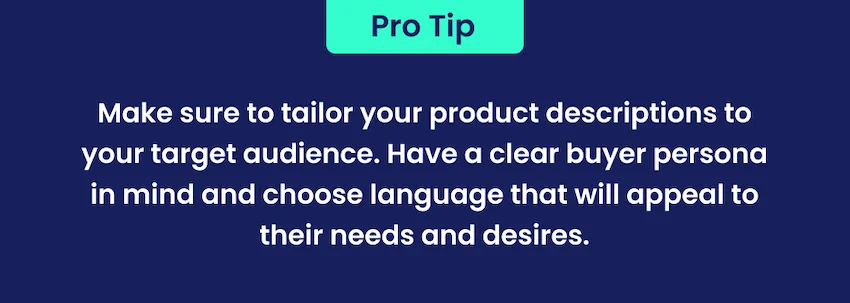
If you don’t know who will buy your product, you won’t know what information to convey. The best product descriptions are targeted ones. The goal is that when a buyer reads it, it will feel like your product is made just for them.
Key points to keep in mind while building a buyer persona:
- Gender
- Interests
- Level of education
- Profession
- Income level
- Location
- Age
- Language
The above-mentioned key points will help you determine which product features to highlight, and what wording will work best for your target audience.
When writing the product description for your items, always imagine your ideal buyer. Are they teenagers who will be interested in your product? Or is your product most suitable for adults? What conversation style do they use?
If you’re selling a baby product, for example, you’ll want to use different wording than if you’re selling the latest trendy shoes for teenagers. Consumers buying baby products are usually new parents, or other adults buying gifts for new parents. You’ll want to highlight safety features as well as ease of use and the benefits for the baby. If you’re targeting teenagers on the other hand, it’s a good idea to use language highlighting how cool and trendy the product is.
3. Express the benefits
Every product has key features, from a smartphone to a pair of sneakers. The trick is figuring out how to present those features in the form of benefits and highlight how they will enhance a buyer’s life.
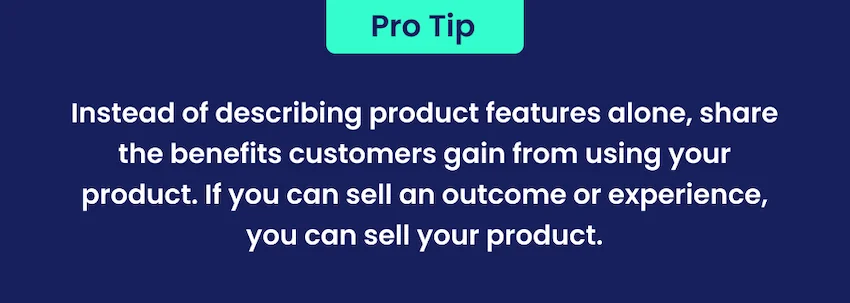
According to data scientists and media analysts, an average consumer attention span has become about 8 seconds. So, you only have 8 seconds to entice them and showcase how your product matters; otherwise, you will lose them.
In order to make a purchase, customers need to know how it will benefit them. A product feature is the quality of a product or something it is made of, while a product benefit is an outcome that buyers will enjoy using your product. If you can sell the outcome, you’ll be able to sell your product.
For example, if you sell waterproof covers for smartphones, the product’s main feature is water-resistant. But the benefit of a product will be explained as “enjoy the sun and sea without damaging your phone.”
Ask yourself the following questions while writing product features and benefits:
- What are your product’s basic features (dimensions, functions, materials, etc.)
- What problems will your product solve?
- Why would a consumer buy your product?
- How is your product better than that of your competitors?
- What are the daily areas of life your product can improve?
- What experience are you trying to sell by selling your product?
- How does it work?
- Is it suitable for specific special occasions or seasons?
Explaining the benefits in easy-to-understand language is also essential because not everybody will read through the product’s technical features or understand them thoroughly.
4. Use sensory words to enhance your description
Words are indeed a potent tool in sales. Failure to utilize words correctly can leave your consumers uninterested and unmoved. When used strategically, however, words can convince people that they simply must have your product.
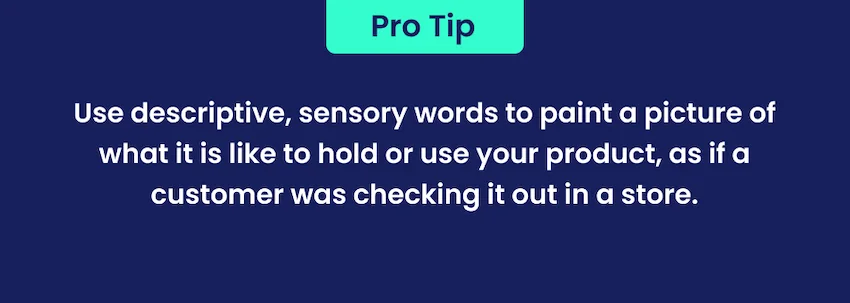
According to research, since eCommerce buyers can’t physically hold the products as they would usually experience when visiting physical shops, you need to connect in more subconscious ways to drive consumers to your product. The use of adjectives can trigger a person’s thoughts and emotions, making them desire the product more. You should do your best to paint a picture of what it is like to hold the product, as if they were checking it out in-store.
Sensory words combined with the product’s benefits and features have the greatest effect on your consumer. For example, if you’re describing an item of clothing, use words such as “inspired” and “breezy” alongside words like “lightweight” and “breathable”. These words describe the clothing while also giving potential buyers an idea of how they will feel wearing it.
Offer your consumers explicit product descriptions, using words like “comforting”, “indulgent”, “sensational”, and “velvety”.
5. Create a connection with stories
Who does not like inspiring and motivating stories? Product narrative is an essential concept for adding value to the brand. It can also help you develop your brand narrative.
Sharing stories creates an emotional connection between you and your buyers. While listing the product features and benefits is an irreplaceable part of making a great product description, stories can add a bit of oomph. If you tell the right story, it can be a powerful technique for high converting product descriptions.
For example, if your product has an interesting background, you can share it with potential customers. Let them know how you came up with the idea for your product, or if there was a particular inspiration behind it. Perhaps it comes from a long-held tradition or is made with a material that has an interesting backstory.
When searching for a story to include in your product description, ask yourself the following questions:
- Who makes the product?
- What was the inspiration behind creating the product?
- What challenges did you face in developing the product?
- What is unique about the story of this product’s creation/development that would be interesting for people to know?
Remember, a story shouldn’t take the place of product features and benefits, but it can add to it. If you do choose to include a story, keep it brief and to the point.
6. Optimize Product Titles and Descriptions for SEO
Dazzling product titles and descriptions capture your buyer’s attention, but if you want potential buyers to find your product, you need to make sure it ranks in search engine results. SEO, or search engine optimization, is the process of improving the ability for your website to show up in online searches. This requires time and effort but is an essential part of succeeding in eCommerce.
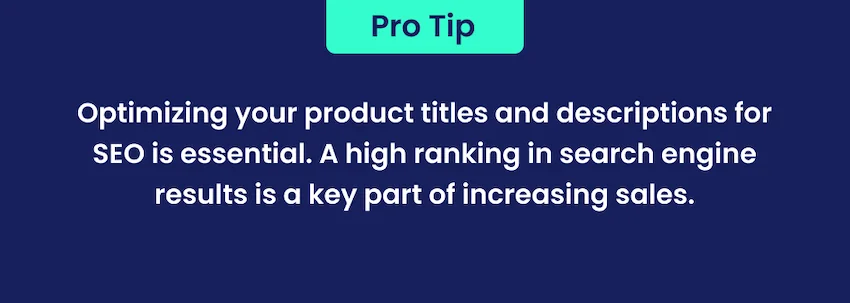
The first step in SEO is research. Find the most relevant keywords for your product by finding out what customers are searching for and what keywords your competitors are using. Tools such as Semrush and Ahrefs can be a big help. Once you know which keywords you want to rank for, fit them into your product title, descriptions, meta title, image alt text, and backend keywords.
While including as many relevant keywords as possible can help, you also don’t want to sacrifice the quality of your listing. Don’t stuff your listing with keywords at the expense of readable content, because that backfires. Search engines prioritize high quality content, and if consumers can’t easily read your product titles and descriptions, they aren’t likely to buy from your brand.
to our blog
Read the latest
from 8fig

From AI-powered styling to virtual try-ons, learn about the innovations transforming the fashion industry and enhancing the shopping experience.

Explore the pros and cons of lump sum loans vs. just-in-time funding, and discover why JIT funding could be the game-changer your eCommerce business needs.
![BFCM: The ultimate guide to eCommerce sales [2024]](https://www.8fig.co/wp-content/uploads/2023/09/cover-2-768x432.jpg.webp)
Get ready for Black Friday and Cyber Monday with our guide on maximizing sales through smart inventory management, effective marketing strategies, and leveraging eCommerce financing.
